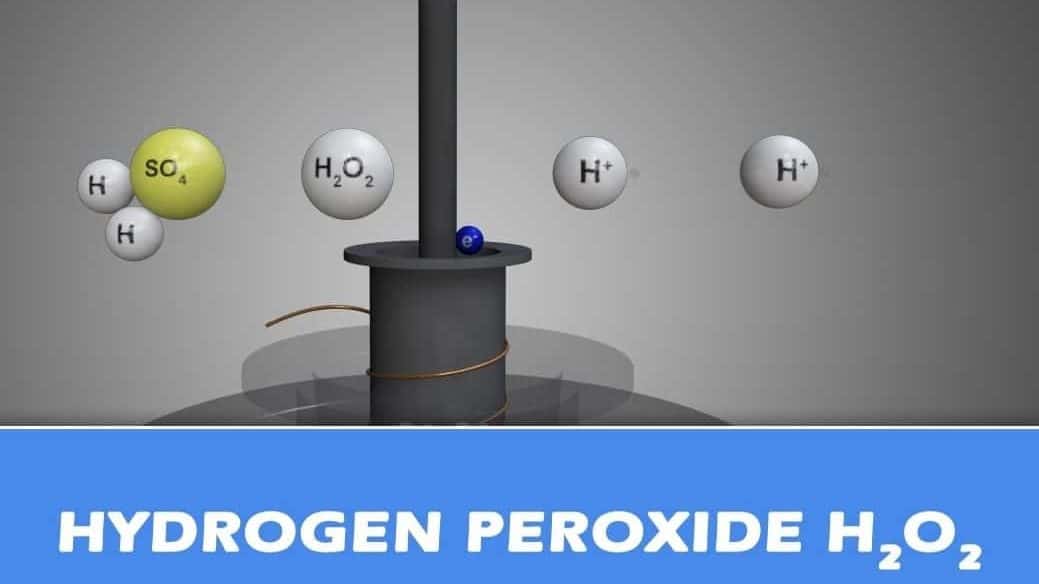You may have a bottle of hydrogen peroxide (common household disinfectant) in your cleaning cabinet or medicine chest.
Hydrogen peroxide is used for cleaning and sterilization. It is also known as a bleaching agent and is used to ensure that the germs are kept away from the surfaces of the table.
This particular compound (chemically represented as H2O2) has much more to provide than just cleaning. Hydrogen peroxide is a perfect home remedy that can be used to fight infections, detoxification, relieve pain and many other applications inside and outside the home.
Discovery and Manufacturing of Hydrogen Peroxide
In 1818, hydrogen peroxide was defined and produced by treating barium peroxide with nitric acid. This process was used to create hydrogen peroxide until the mid-twentieth century. A better version of the compound was created when hydrochloric acid was used to treat barium peroxide.
Sulfuric acid is used for this purpose lately, a process that also provides manufacturers with barium sulfate as a byproduct. Most of the hydrogen peroxide today is produced by the “Anthraquinone” process, as indirect synthesis of elements based on the reduction of oxygen.
Hydrogen peroxide is available in different potencies and concentrations. It is soluble in water and is also available in solution.

How Effective Hydrogen Peroxide as a Remedy
The Technical Explanation
Have you ever wondered why rainwater is more beneficial than tap water? To understand this, we need to understand the chemical compositions of three things: water, hydrogen peroxide, and ozone. Hydrogen peroxide (H2O2) has an oxygen atom more than water (H2O).
The protective layer of earth, ozone, contains three oxygen atoms (O3) and forms when ultraviolet light divides atmospheric oxygen (O2) into two unstable oxygen molecules. These oxygen-free molecules combine to form ozone.
The problem is that ozone is unstable and easily transfers the extra oxygen atom to the rainwater that produces hydrogen peroxide (H2O + O = H2O2). It is this hydrogen peroxide in rainwater that makes it more effective than tap water.
Mechanism
Hydrogen Peroxide is a germicidal agent that destroys microorganisms by oxidation, a process that can be called controlled combustion. On application or ingestion, it reacts with organic substances to decompose them in their elemental form. This separation of water and oxygen pushes extra oxygen into the system, creating an environment in which harmful bacteria or viruses can not survive.
The fact that hydrogen peroxide can kill germs through a process called oxidation makes it the safest and most natural disinfectant in the world because it is composed only of water and oxygen. It detoxifies the system and acts as a germicidal, antibacterial and antiviral agent.
Research indicates that hydrogen peroxide is also needed for many chemical reactions in our bodies. Vitamin C, a powerful antioxidant, has been shown to produce hydrogen peroxide to fight infections.
Hydrogen peroxide acts to stimulate the active lipid compounds (prostaglandins) production that have a wide range of positive effects, such as:
- Accumulation or separation of platelets
- Regulation of inflammation
- Alleviation of pain by sensitizing spinal neurons
- Ability to act on the hypothalamus to produce fever
- Hormone regulation
- Control of cell growth
- Induction of labor
- Inhibition of acid secretion from the stomach wall
- Reduction in intraocular pressure
- Dilation in vascular smooth muscle cells
- Regulation of calcium transportation
- Increase in glomerular filtration rate
Health Benefits of Hydrogen Peroxide
One of the health benefits of hydrogen peroxide is cleaning wounds, eliminating parasites, relieving toothache, treating sinus infections, detoxification and treating cancer. Each of these has been detailed below.
Wound cleansing: The most popular hydrogen peroxide application. The compound is often used to clean wounds. When applied to wounds, it acts as a germicide by oxidizing organic matter in the wound and preventing infection.
Washing and rinsing are sufficient, but some experts recommend to soak the wound in a solution of hydrogen peroxide for ten minutes. The solution can also stop bleeding from the wound. It is important to keep in mind that hydrogen peroxide can cause minor damage to open wound tissues if left open for prolonged periods.
Foot Bath for Athlete’s Foot: A 50-50 of hydrogen peroxide and water solution can be used for a foot bath for an athlete’s foot. Diabetic patients reported relief from blood circulatory problems by soaking their feet in dilute H2O2 (1 pint of 3% solution mixed with 1 gallon of non-chlorinated warm water) for 30 minutes each day.
Sinus infections: Hydrogen peroxide is very effective at treating sinus infections. A tablespoon of 3% hydrogen peroxide solution in a cup of non-chlorinated water can be used as a nasal spray. This can clean the nostrils, eliminate bacteria and prevent the worsening of the disease.
Mouth and Tooth Care: Dentists use hydrogen peroxide for its excellent germicidal and healing properties in procedures such as root canal treatment. It can also be used as a home remedy to whiten teeth, relieve toothache and as a mouthwash. Some even recommend it as an additive in toothpaste.
Hydrogen peroxide is an economical but effective mouthwash. An interesting alternative is to use a solution of 3% hydrogen peroxide with a little chlorophyll (optional) to aromatize it. Mixed with a little baking soda it can form a thick paste to use as a toothpaste.
Hydrogen peroxide can be used for dental care and tooth whitening, without incurring additional expense due to costly strips and uncomfortable trays.
Efficient Cleansing of the Colon, Enema, and Douche: Two cups of a 3% hydrogen peroxide solution in a gallon of warm water is an effective colonic and can eliminate various toxins. A tablespoon in a quart of lukewarm water works well as an enema. Two caps of 3% solution in warm distilled water can be used as a douche to eliminate yeast infections.
Although hydrogen peroxide is used for these applications, it is imperative to maintain a good bacterial flora. It is also recommended to use the recommended dilution level for these applications in order to get the most out of the remedy.
Mites Infection: Hydrogen peroxide is an incredible remedy for skin infected by mites. Apply twice to the infected skin, leaving a few minutes of rest between applications. You can also add two quarts of 3% hydrogen peroxide to your bath and soak for at least half an hour to eliminate mites and other toxins. This will not only kill the infection but also rejuvenate you.
Toothache Relief: Hydrogen peroxide is not an analgesic, but a healing agent. It eliminates the pathogens effectively that cause infection and inflammation, the underlying cause of toothache.
If you suddenly develop a toothache and unable to go to the dentist immediately, put 3% hydrogen peroxide in your mouth for ten minutes and spit out. Do it several times a day and you will see an exceptional reduction in pain.

Inhalation of Hydrogen Peroxide
The inhalation method is one of the most popular ways to use hydrogen peroxide for internal purposes. According to Bill Munro (March 1924), it is possible to reduce the high levels of PSA caused by prostate cancer by inhaling hydrogen peroxide using a nasal spray pump. Recommend dosing of five pumps, six times a day.
Inhalation therapy is easy. Any nasal pump would work as long as it sprayed a fine mist. Empty the contents of the nasal pump and wash thoroughly to rinse all soap water.
Fill it with 3% hydrogen peroxide. Point the bottle towards the back of the throat and inhale strongly. Do this five times at a time. Be careful not to breathe through your nose.
To treat the viral infection, you must pump every two hours. It may take a day and a half or two days for the infection to disappear. For infections that have persisted in the blood for a long time, it can take between one and two weeks.
Other Uses and Benefits of Hydrogen Peroxide
In addition to the health benefits mentioned above, you can benefit from many other applications of hydrogen peroxide.
Hair lightening: It can be used to lighten the color of your hair as a bleaching agent. A 50-50 of hydrogen peroxide and water solution sprayed on wet hair can diminish the complexion of hair. The cost of this solution is nothing compared to commercial hair dyes that can be expensive and damage the hair in the long run.
Versatile Disinfectant: The combined use of hydrogen peroxide and vinegar (which are not mixed but used separately at the same time) is much better than the use of commercial bleach. It is non-toxic and kills almost all E. coli, Shigella and Salmonella bacteria in contaminated food, as well as on surfaces. When sprayed separately on vegetables, cutting boards, sinks, countertops and floors, vinegar and hydrogen peroxide mix for a short time, which leads to a chemical action that produces a new compound, a powerful sanitizer and disinfectant.
Removes Stains: A solution of 3% hydrogen peroxide can be used as a powerful stain remover. It can fight against blood stains up to two months old. Be careful not to use it too much to protect your clothes from discoloration.
Dishwashing: Add 2 ounces of H2O2 to the water before washing dishes or putting in the dishwasher. You can be sure that dishes and cutlery do not contain germs.
Fabric Bleach: Instead of synthetic bleach, use H2O2 to bleach white clothing.
Domestic Cleaning: Hydrogen peroxide can be used to clean glass, counters, and mirrors. The trick is a bottle of 3% hydrogen peroxide or a few drops on the dust cloth. This will not only kill the germs but will also leave a fresh smell.
Soak Vegetables and Meats: Use 3 percent H2O2 (one-fourth cup in full sink of water) and soak vegetables and meat before cooking to remove harmful chemicals and bacteria present.
Understanding Different Concentrations of H2O2
Regardless of the form, hydrogen peroxide is suitable as a home remedy. Care must be taken to use the correct concentration for different purposes. Not all concentrations are meant for internal use.
Hydrogen peroxide is classified according to its use. Concentrations range from 6% (pharmaceutical grade) to 90% (as an oxygen source for rocket fuel).
Food grade hydrogen peroxide is a purified form of the compound produced for this purpose. Food grade hydrogen peroxide has a concentration of 35% and is more powerful than what you will find in supermarkets.
However, at this concentration, it is a potent, powerful oxidizer and dangerous to consume unless diluted. Concentrations above 10% may damage you and must be diluted before ingestion.
The use of food-grade hydrogen peroxide in a wound will cause a burning or stinging sensation, but will not damage healthy tissue.
Conclusion
When we discuss the antibacterial properties of hydrogen peroxide for various internal and external uses, we must understand that the good bacteria (in the colon and vagina) are aerobic. They depend on the outside or oxygen to blossom.
Harmful pathogens are anaerobic and they can thrive without the presence of oxygen including cancer cells.
There is no controversy about the effectiveness of the hydrogen peroxide produced in the body. It is considered essential for life. There is also no controversy regarding the topical use of the compound.
Today’s controversy stems from the refusal of the medical community to treat any treatment beyond traditional allopathic drug regimens as effective.
Hydrogen peroxide is safe if used according to established guidelines for internal use. It is also an effective and natural product that can help eliminate bacteria and viruses.
The effectiveness of hydrogen peroxide can be measured by the fact that colostrum (the mother’s first milk) contains high amounts of hydrogen peroxide.
Safe and Effective Herbal and Homeopathic Remedies
Native Remedies is the leading brand on the market of natural remedies formulated to offer a complete solution for holistic health and well-being.
With more than 500,000 customers worldwide and over 250 medicinal plants and homeopathic remedies, we are sure you will find the holistic health products you need.
Find out how our wellness dual-modality approach can provide symptomatic early action relief (homeopathic) and improve bodily functions for long-term holistic health (herbal), and discover the body’s innate sense of healing with tissue salts and floral essences.



